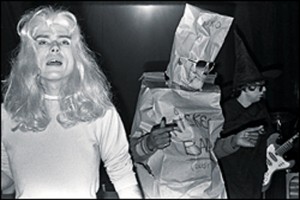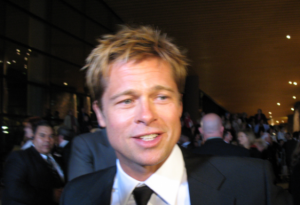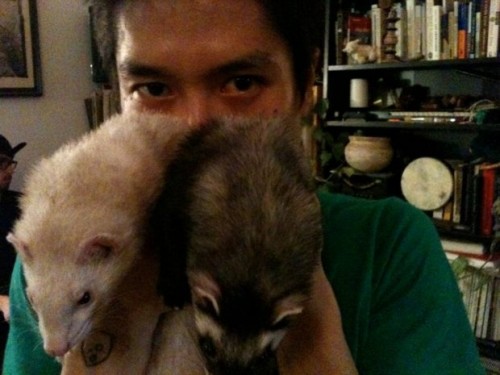What’s so great about art?
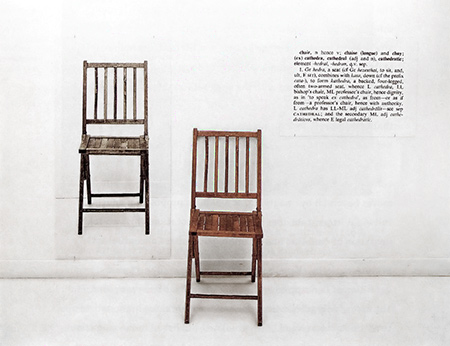
Joseph Kosuth, “One and Three Chairs” (1965)
[Update 4 October 2014: See the bottom of this post for a bit more.]
This is a response to this recent post, which is itself a response to Janey Smith’s “Fuck List,” originally published at this site. It’s also a response to the numerous comments on the original post. Because it seemed to me that, as of this writing, a lot of the debate over Smith’s post, and the book that’s apparently resulted from it (which I’ve not seen), has taken the form, “Is what Smith did art?” Mind you, I doubt this post will settle that debate, but I hope it provides
- some historical context I think relevant to Smith’s post;
- plus an argument why, at the end of the day, I don’t think that it really matters whether Smith was making art.
I guess I should also note, in passing, that my name was the first name on Smith’s “Fuck List” (thanks to the magic of alphabetization). Since I find myself (along with numerous others) the object of some obscure desire, perhaps I can offer a few thoughts on the subject.
On Tao Lin’s Taipei
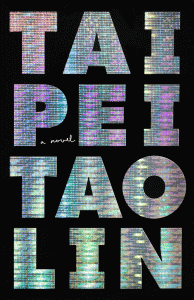 Taipei
Taipei
by Tao Lin
Vintage, June 2013
256 pages / $14.95 Buy from Amazon
Tao Lin is a writer whose novels, short stories, poetry, and essays have won many admirers, and inspired what seems like an equal amount of detractors (it’s a conversation being energetically carried out on the Internet, for the most part). His recent novel, Taipei, is his most publicised book. It’s about a young writer living in Brooklyn who ingests lots of illicit and non-illicit drugs, uses his MacBook to ‘work on things’, goes on a book tour, visits his parents in Taipei, ingests more drugs, and tries to connect with people.
Though I’d come across bits and pieces of Tao Lin’s writing online, my response was emphatic in neither a positive or negative direction, and it would hardly constitute a bias. The thrill, therefore, I got from reading the first sentence of Taipei was pure, and due as much to my having an immediate feeling as it was to the sentence being good. I’ll reproduce it here, for the pleasure of doing it, and possibly to annoy anyone who doesn’t agree with me: It began raining a little from a hazy, cloudless-seeming sky as Paul, 26, and Michelle, 21, walked towards Chelsea to attend a magazine-release party in an art gallery. As far as sentences go, it’s accessible, controlled, and idiomatic. Its tone, too, is consistent throughout the novel – which could pass as one definition of good writing. In regards to Tao Lin, whose prose veers so close to ‘bad writing’ that it sometimes reads like parody of bad writing, it’s an important distinction to make.
I’ve read that Tao Lin completed his bachelor’s degree in Journalism. Although it’s a bad habit to speculate on a writer’s influences, I can’t help but draw a connection between this biographical fact and his third novel. For one, Taipei is an autobiographical account covering 18 months. The novel is, for the most part, chronologically linear, and much of what happens finds its genesis in Paul’s (journalistic?) impulse to self-document. There is the absurd, fake documentary Paul and Erin decide to make about the ‘first’ McDonald’s in Taipei; filming themselves on MDMA and other drugs to post on YouTube; live-tweeting X-Men First Class while on heroin; writing accounts of their first ‘drug fight’ (both Paul and Erin render it in a ‘Raymond Carver-esque manner’, as it happens); Paul emailing himself a bullet-point account of a dinner with Erin parents, etcetera.
What’s most interesting, though, is the manner in which Tao Lin uses as a model journalistic prose. In doing so, he upends certain expectations of artistic and imaginative writing. For instance, there is a pretence to objectivity that characterises much reportage, and it results in writing that is cold and impersonal; this is a quality mimicked in Taipei, whose sentences are often flat and literal. However, while this is what the surface of the prose conveys, what it’s actually presenting is a third-person voice so close (and indistinguishable from Paul) that it is radically subjective. Tao Lin adopts stylistic traits associated with the opposite of ‘literary’ writing; a denotive, sub-literary style becomes prose whose innate quality is not what it seems. The agility and nuance of the syntax can balance multiple clauses, and take the reader off-guard with the most unlikely images.
On the plane, after a cup of coffee, Paul thought of Taipei as a fifth season, or ‘otherworld,’ outside, or in equal contrast with, his increasingly familiar and self-consciously repetitive life in America, where it seemed like the seasons, connecting in right angles, for some misguided reason, had formed a square, sarcastically framing nothing -or been melded, Paul vaguely imagined, about an hour later, facedown on his arms on his dining tray, into a door locker, which a child, after twenty to thirty knocks, no longer expecting an answer, has continued using, in a kind of daze, distracted by the pointlessness of his activity, looking absently elsewhere, unaware when he will abruptly, idly stop.
One specific example of a stylistic signature that Tao Lin has made his own is the noting of the age of any person in Paul’s social life (as in the novel’s opening sentence). I’d say this does at least two significant things. Firstly, as I’ve mentioned, it’s reminiscent of purposely bland, direct reporting; and secondly, it satirises a contemporary social reality. Among creatively ambitious people (and the twenties might be its most intense manifestation) age is tied to notions of precocity and perceived achievement. Socially, these are two things many people want to embody, and which are the cause of much anxiety. As trivial though it may seem, the curiosity surrounding a social rival’s precise age, for many of us, is hard to overcome (often it’s the only thing we want to know).
His style also makes use of what can appear an egregious placement of adjectives. ‘Dancey’ music, or, a ‘vague’ amount of time: these are just two instances of a writer who might seem bored with writing. After all, it’s the sort of silly shorthand we use when we’re being lazy in real life. On the other hand, however, it’s also unsettling close to how many supposedly over-educated people speak, and narrate internally (as Paul is doing). To me it’s funny for its accuracy. And more than just comic effect, it captures the way clever, emotionally-isolated people can use language to distance themselves from their concrete surroundings, other people, and their own feelings. (A similar thing is achieved by the use of stock phrases and cliche, as contained in those now ubiquitous ironizing quotation marks.)
This all being the case, I’m not going to deny there was a point about mid-way through the novel when I put it down with the thought I’d had enough. Some of the long, diffuse sentences seemed unnecessarily confusing: It had seemed like they would never fight, and the nothingness of the future had gained a framework-y somethingness that felt privately exciting, like entering a different family’s house as a small child, or the beginning elaborations of a science-fiction conceit. But when I did put it down, I found the novel’s voice was stuck in my head. There is something about a sentence like the one I’ve just quoted which, to my mind, resembles pre-articulate thought. The spirit of Henry James hovers over the pages of Taipei. A Jamesian sentence does the impossible, it gives an impression of the inchoate process of consciousness, and at the same time, it crystallises multiple thoughts (all in what appears to be a single thought). A Tao Lin sentence makes the journey from inside Paul’s head, onto the paper, untransformed; in other words, it is an underdeveloped version of a Jamesian sentence in which nothing is crystallised. Tao Lin’s portrayal of the inner life is similar to the common experience of thinking like a genius, and when it comes to articulating the thought, speaking like an idiot (I’m misappropriating Nabokov.)
Which brings me to a final comment. It is tempting to read Paul (Tao Lin’s fictional avatar) as intended to be representative of an entire generation (or at least one of its more visible sub-groups – namely, Brooklyn-dwelling literary poseurs). But I don’t think that is the intention. To me, Paul is strange (and maybe even unique); and despite frequent moments of recognition, reading Taipei is not like looking into a mirror. For all its representation of a life lived through the internet, the novel’s aim is a traditional one.
…[Paul] uncertainly thought he’d written books to tell people how to reach him, to describe the particular geography of the area of otherworld in which he’d been secluded.
***
Tim Curtain writes fiction and lives in Melbourne, Australia. His reviews and stories have appeared online and in print.
January 20th, 2014 / 10:00 am
Boys Who Kill: Cho Seung-Hui
The next installment of Boys Who Kill stars Cho Seung-Hui, or Seung-Hui Cho, or Question Mark. On 16 April 2007, 4 days before the 7th anniversary of Columbine, Cho killed 32 people at Virginia Tech. First he visited West Ambler Johnston Hall, a dorm room for both boys and girls, where he killed one boy and one girl. Then he traveled to Norris Hall, a classroom building, and killed 30 more people.
Ever since Cho was taken out of his mommy’s tummy he hasn’t taken to talking. “Talk, she just him to walk,” says Cho’s great aunt about his mommy. “When I told his mother that he was a good boy, quiet but well behaved, she said she would rather have him respond to her when talked to than be good and meek.” At Virginia Tech, one of Cho’s roommates remarked, “I would see him walking to class and I would say ‘hey’ to him and he wouldn’t even look at me.” Other students concluded that he was a deaf-mute. He ate myself all by himself, and when someone offered him 10 dollars to say something, he said nothing. According to medical professionals, Cho suffered from “selective mutism.”
I, too, would prefer to be mute, and so, it seems, do other boys. Holden Caulfield dreams about being a deaf mute, and, it’s been reported by various biographers that instead of engaging in dinner table conversation, Arthur Rimbaud would just growl. Talking is terribly human — this race of creatures does in it grotesque quantities: they talk at Whole Foods, at overpriced bars, at trendy coffee shops, and, obviously, through Gmail, Gchat, texts, Facebook, Twitter, Disqus, and so on.
Cho’s contempt for normal communication distinguishes him from humans. Virginia Tech students and teachers constantly construct Cho as boy who confound expected human behavior. A professor labeled him “disturbing” and “unusual.” A student in his playwriting class said Cho “was just off, in a very creepy way.” According to Nikki Giovanni, students started skipping her poetry class due to Cho’s behavior . When Nikki told him to either cease composing sinister poems or drop her class, Cho replied, “You can’t make me.” Eventually the then head of the English Department, Lucinda Roy, tutored him privately. But even Lucinda was afraid of him. During the one-on-one tutoring appointments, Lucinda and her assistant agreed upon a code word that would prompt the assistant to summon security when uttered.
Based on this testimony, Cho is similar to a virus or a disease. No one wants to be around him; everyone is horrified of his presence. Not one to stay up into the wee hours of the morning to drink, party, and partake in sexual intercourse, Cho went to bed early and awoke early. He also played basketball alone. According to the New York Times, Cho was in a “suffocating cocoon.” (Being in a “suffocating cocoon” seems very dramatic and cosy; it also seems as if a “suffocating cocoon” would provide protection from mankind.) Virginia Tech journalism professor Roland Lazenby sums up Cho as a “shadow figure, locked in a world of willful silence.” Both Lazenby and the Times portray an incomprehensible boy who, isn’t free and liberated like Western subjects, but is held captive by a dark dangerous force. As Theresa Walsh, a girl who witnessed the killings in Norris Hall, says, “I’ve never really thought of him as a person. To me, he doesn’t have a name. He’s always been just the ‘the shooter’ or ‘the killer.'”
No Thanks: A Simple Wish for the Ends of Alt Lit
Last week I watched Nathan Staplegun eat salted peanuts on spreecast. What started off as Nathan eating salted peanuts soon turned into Nathan asking his roommates or friends (and thus turning the computer camera in their direction) what they were preparing in the kitchen, and quickly became a spreecast showing one of Nathan’s online friends playing guitar. On the surface, Nathan Staplegun eating salted peanuts on television (that’s what platforms such as spreecast are: do-it-yourself TV) would seem like a snooze, a no-brainer, an excuse to read more books. But, what Nathan did was really great. He put on TV a thing that he would have done anyway and by doing it on TV turned the act of eating salted peanuts into something else: an event, perhaps.
I love to tell the story of Glenn O’Brien’s TV Party. In 1978, Glenn O’Brien and friends (and his friends were people like Jean-Michel Basquiat, Amos Poe, Deborah Harry, Walter Steding, Chris Stein) got together and decided to take advantage of public access cable television in New York City. The format was simple: hang out with friends, get high (one episode had Fab Five Freddy in costume teaching viewers how to roll perfect joints), have your friends play music, and talk to people (viewers called in live while the show was on air and used their short time to make death threats and complain about how shitty the show was). By television’s standards, the TV Party shows were shitty, but they were fun to watch. And, in their own way, became increasingly popular (special guests included David Byrne, Klaus Nomi, and Mick Jones of The Clash) and influential (in one of his early top ten lists David Letterman cited TV Party as an influence). Art and everyday life will never be separate things; although, the art marketers sure seem to want us to believe that they are. Friends get together, record each other doing silly things, or someone we hardly know broadcasts himself washing dishes or whatever, and art’s possibility is renewed, if not, realized.

The word ‘creepy’ has not always had negative connotations. Vito Acconci follows people around New York City as part of his month-long performance ‘Following Piece’.
I have been kicking around the idea of starting a series of posts in which I cruise my facebook friends’ facebook photos and post the ones I like as part of ‘Creeper: Favorite Facebook Photos of My Facebook Friends’. The word ‘creep’ (and its variations) has not always had negative connotations. When Radiohead hit the pop charts in 1992 with their debut single “Creep” the song seemed like a strange, wonderful call to embrace the pathos of a loser, a lost subcultural weirdo whose dreams and desires are too much for himself and the world. Much like Beck’s “Loser” the song seemed to reinvigorate a long-standing yet dangerous tradition in the arts: the elevation of the low, the loser, the outsider, the emotional clown, to the status of cultural barometer, of artist. Long-standing because American cultural producers had carefully exploited this type for profit since the early days of white rock ‘n’ roll (Elvis Presley) and the first teen films (Rebel Without A Cause). Dangerous because sometimes people actually believed in these characterizations enough to begin to act like rebels, not satisfied with merely listening to them on the radio or watching them at the movies.

It’s not Dennis Cooper’s male escorts of the month. It’s The Bad News Bears (1976), who demonstrated that life sometimes artfully happens when a bunch of losers get together and push the game to its limits.
In 1969, Vito Acconci made art by simply following people around New York City. Acconci spotted someone on the street and followed them until they disappeared into a place he couldn’t, or didn’t, want to go. Acconci’s performance lasted almost a month. He’d get up, go outside, spot someone, and follow. Most spreecasts, for better or for worse, go on way too long. But, so does hanging out with one’s friends. At some point, you want to be by yourself or hang out with someone else. With the advent of the spreecast you can hang out with people you know or don’t know or want to know simply by joining in. It’s the logic of the club but not as restrictive. Of course, hanging out on spreecasts may never beat the intimacy of being in the same room with a friend or a loved one or turning it all off and reading a book. But I’ve known a lot of people who got all the companionship they needed by simply watching episodes of Breaking Bad or whatever–and apparently, according to some, you can be plugged in and still experience solitude.
This isn’t a plug for spreecast, who I could give two fucks about. It is a plug for a kind of art that denies the art market and realizes itself in everyday life. One doesn’t need an important architectural group, a big publisher, and a major museum to support an effort to follow and document people in your neighbor (although Acconci had all of those). One does need ideas. I was talking to Elizabeth Emily D’Agostino in her car about art. We were parked outside my apartment–a perfect venue to discuss anything. Our conversation shifted to cultural amnesia, an easy target. In our desperate efforts to predict the future I described for her a story written by Tao Lin and boldly proclaimed that this was Lin’s crowning moment and that history would look at this moment as an opportunity lost. The story is simple enough:
when i was five
i went fishing with my family
my dad caught a turtle
my mom caught a snapper
my brother caught a crab
i caught a whale
that night we ate crab
the next night we ate turtle
the next night we ate snapper
the next night we ate whale [. . .]
The last line of the story is repeated almost endlessly or as long as the writer/reader can endure it. Although, I have read a version of it where it ends rather abruptly. For a video account of its hilarity, you can listen to Tao read it here.
Why an opportunity lost? Because when an artist with the talent of Tao Lin comes along he seems to come with a two-pronged fork capable of reflecting the zeigeist back to us and/or breaking the hold the zeigeist has on our attitudes, desires, fashions, discourses, etc. In the post-Warholian world in which we live contemporary artists have made it clear that they are more interested in and perhaps more capable of showing us who they are (i.e. reflecting the ‘zeigeist’ back to us) than breaking the mirrors that bind us to a social-medial and political-economic worldview that reinforces the notion that ‘we’re fucked.’

May 1968, France. Today, the attitudes and aspirations of the ‘me generation’ of the 1970s have resurfaced in the attitudes and aspirations of millennial artists.
We are fucked. In Sheila Heti’s novel, How Should a Person Be?, someone comes up with an idea for an ugly painting competition. I say ‘someone’ because not even Sheila, our narrator, knows who came up with the idea. The idea of making the ugliest painting is more difficult than you’d think. Relationships are ended, lives are changed. During the height of the national crisis that was punk rock in England in the 1970s, a roadie for The Who dismissed the movement as a mere ‘revolt of the uglies.’ I mean, imagine calling a bunch of teenagers parading their misfortunes, economic hardships, childhood traumas, bad skin, social awkwardnesses, and fashion made of actual garbage found in the street as revolting or, worse, ugly? It is with these two sentiments in mind–a conceptual call to ugliness in the name of something else (Heti) and its celebration as an insult (punks)–that I invoke the writers and artists of the alt lit movement, a movement that has come to signify everything that’s right and wrong about everything that’s fast, cheap, and out-of-control in the arts today. Perhaps the time has come to break the mirrors that bind us to our own little personal victories (i.e. ‘I’m internet famous’) and begin the more fun and difficult work of smashing those fucking mirrors so that we–and the big, bad world–may see ourselves again, as something else, something more, something seemingly uglier and thus, perhaps, more beautiful. Of course, you could choose to ignore me (I’m used to it, really)–your career path probably profiting more from it–than listen to me whisper to you, from the salted peanut gallery.
@janeysmithkills
kottonkandyklouds.tumblr.com
No End to Things That Are Not Holograms
The company responsible for the Tupac hologram that performed at Coachella last year, Digital Domain Media Group, recently went bankrupt, somehow, despite the millions pouring in from investors, the $400,000 Dr. Dre himself reportedly paid for the puppet Tupac, and funded plans they had to resurrect Elvis as a hologram and possibly pitch holograms to political candidates to deliver virtual speeches this upcoming election.
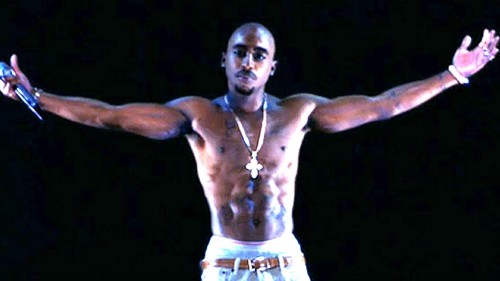
Ok, so Tupac is double dead now, him and his hologram. Sort of. I mean some still insist he is not physically dead, but one thing for certain I feel moved to clarify is that he was never a hologram. Not even remotely close.
The Tupac hologram was simply a high-quality isolated video projection (niced up with 3-D graphics to provide depth cues) on a transparent screen (a sheet of mylar stretched across stage). Not very different, technologically speaking, than what you see when you go to the movies. It was sold as a hologram because it seemed like a free-moving 3-D object “beamed” from some magic device, like what we saw in the first Star Wars movie when Princess Leia sent an image of her bodily form to convey a message to Obi-wan instead of just simply sending a recording of her voice or some writing. (The significance of her using her whole, three-dimensional (but shrouded) body to plead her message, virtually, is a topic for a different article, but of course this fictional technology is already inspiring a robust pursuit at MIT.)
The real name for what you saw in the Tupac trick, or in Gorillaz “live” stage performances of its cartoon members, or in Hatsune Miku, a blue-haired Vocaloid anime girl/voice synthesizer whose songs can be created by users, is the Pepper’s Ghost Illusion, which you have seen if you’ve ever been through the Haunted Mansion at Disneyland. It’s a stage trick involving secret rooms, angled glass and lights that create ghostly images that seem to float and disappear midair. Although mentioned by some news sources, “Pepper’s Ghost Illusion” obviously doesn’t sound as technologically-advanced as “hologram”; in fact, it sounds a little quaint and old-fashioned, which is why marketers haven’t seemed to want to bring it up.
The only reason this misnomer bothers me is that it masks the true facts of real holograms, and the facts are wonderful, more wonderful than the facts of Pepper’s Ghost Illusion. I recently finished writing a whole book inspired by the facts of holograms borne out of an accidental obsession that started when, for no reason I can remember, I looked up holography on Wikipedia. READ MORE >
Comment on This Post: Giant Triple Threat Giveaway (Ken Baumann, Marie Calloway, Tao Lin)
I know there was a Tao Lin post x hours ago, but I don’t care. I have books to give away. Want to win free books? Want to grumble? Comment on this post to get one of these:
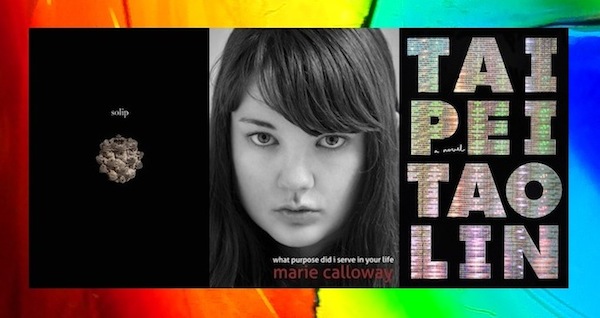
FIRST PRIZE goes to the commenter with the best* comment
SECOND PRIZE goes to the commenter with the worst* comment
THIRD PRIZE goes to the commenter who makes the MOST* comments (bonus for over 100)
each prize will be selected randomly from the (pictured) prize pool of:
Solip by Ken Baumann
what purpose did i serve in your life by Marie Calloway
Taipei by Tao Lin
*as calculated by me
(for the curious, the reason I have these books is that I pre-ordered two out of the three, then received ARCs. i bought two copies of Ken’s because I knew it would be badass)
Tao Lin: Extremely Sincere or Total Put On (??)
Tonight (I guess it’s last night by now), in the basement of The Elliott Bay Book Company here in Seattle, Tao Lin read a section of his new book, Tai Pei, to a crowd of about 70-80 people, most of whom were fans.
I’ve read very little of Tao Lin but being a part of the Indie Lit community I have heard his name quite a bit. And I do know that lots of people really like “Tao Lin” and Tao Lin’s writing. And lots of people really dislike “Tao Lin” and Tao Lin’s writing. And as we walked into the bookstore one of my new Seattle buddies underscored this with the phrase “very polarizing.” My friend was referring to Tao Lin’s writing but I guess he could just easily have been referring to “Tao Lin.”
Tao began by apologizing for being late (the reading had been pushed back from 7 to 8pm) and explained that he’d missed his 9:30 (a.m.) flight and then his new flight was delayed. Tao sounded a bit under the weather. A bit like he had a sore throat. But, the reading seemed to go ok.
The Q & A, though, is where things got interesting. And pretty quick. The 2nd question was about Tao’s use of Gchat and Gmail. This was, evidently, a touchy subject for Tao and from then on the Q & A, for the most part, was Tao bemoaning the negative reviews (and tweet) Tai Pei has received so far. READ MORE >
The Books I Want to Read During the Summer
Much like Mary Tudor and Anne Boleyn, summer and I are the antithesis of amicable. I hate heat. I heat sweat. I hate seeing human skin. I hate swimming. I hate sunlight. All of these tasteless traits are allotted a starring role in June, July, and August. Already, I want winter to come. The cold, the frost, snow, booties, mittens! Winter is sort of more elaborate than summer. While I never want to be a part of this world, (and by this world, I mean you-know-whos with you-know-what values), I really don’t want to be a part of this world in the summer. Since Mary refused to recognize Anne as England’s queen, I’ll refuse to recognize summer. Instead, I’ll read books (one, obviously, should always read books, since it’s one of the utmost Christian activities), including:
FunSize&BiteSize by Ji Yoon Lee: She resembles a cute tiny kitty who everyone wants to pet, only no one actually does, since nearly everyone is aware that if you attempt to do such a thing then she’ll bite you, and while that bite may not hurt much at first, eventually it’ll turn into a disease much more fatal than the kind gay people get. A preview: “Fetishize my misery / Not white American male’s.”
I Will Never Be Beautiful Enough to Make Us Beautiful Together by Mira Gonzalez: She seems sad, depressed, moody, discontent, and all the other things that most anyone with any perceptiveness would be right now. She also has a rather captivating name. “Mira” is light and delicate, like a fine piece of fabric. “Gonzalez” is also the last name of the former Texas Ranger baseball player Juan Gonzalez. This All Star constantly hit home runs, which are quite dramatic. Preview: “i feel like 400 dead jellyfish in the middle of a freeway.”
Lemonworld & Other Poems by Carina Finn: She’s basically a modern princess (one of the poems in this book is titled “modern princess”) who has come home for winter break to visit her mommy and sigh flippantly and eloquently at the whole entire universe. Carina likes yummy food (browniemix), fashion accessories, like ribbons, violence (“peace is a field of graves”), and the types of things Gertrude Stein would like — “16-year-old girl looking to buy a moustache.” To spotlight her forceful mercuriality, Carina includes plentiful exclamation points, one of the most comely types of punctuation marks ever. A couplet: “don’t trump the mode / there’s a rabbit in the marshmallow!”
Pageant Rhymes by JonBenét Ramsey: Last summer, the cute Tumblr literary corporation Bambi Muse published Baby Adolf’s Nursery Rhymes to much acclaim. Even presumed adversities (presumed, due to a certain trait) were laudatory. “Nothing to complain ’bout here,” was Saul Bellow’s hearty response. This summer, Bambi Muse will publish a collection of couplets by the sensational JonBenét. The verse touches on yummy victuals, fashion, and other things. A couplet: “Cheddar broccoli soup is most profound. / I was killed in my pink Barbie nightgown.”
Taipei by Tao Lin: This boy, though a straight boy, seems like a manipulative psychopath, so I’m invariably curious about his compositions.
TwERk by Latasha N. Nevada Diggs: A little bit ago, Joyelle McSweeney posted about these poems. From what I’ve read, they contain the qualities of a circus as well as a loud, unmitigated drag ball. Even the author’s name teems with theatrics. Nevada is home to quite a few cinematic creations, like Casino (a mafia movie) and Liberace (a boy first and now a movie starring Michael Douglas and Matt Damon).
The Diary of Anne Frank by Anne Frank: I’ve read this book bountifully, obviously, and I will continue to do so during the summer months (and I’m not talking about the Sex and the City version either!) Caitlin Flanagan says Anne is an “imp, a brat, a narcissist, a sulker, a manipulator, a manic talker, a flirt, and a person who insisted on the rapt attention of everyone around her at one moment, and on the pure privacy that all misunderstood people demand at the next. ”
Petocha/Chiflada by Monica McClure: The sharply chic Mona is publishing a bratty chapbook with wtfislongsdrugspress, a new press founded by Carina and Stephanie Berger, the princess of The Poetry Festival. It’s invariably estimable when tiny, pretty girls work together on a particular project, it’s kind of like an episode of The Babysitters Club.
The Bible: A ton of people are on a path to hell, but by perusing this text (not just for summer, either) they just may be able to take the trail to heaven, where Edie Sedgwick and Edith Sitwell convene tea parties.
25 Points: Taipei
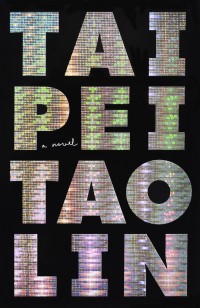 Taipei
Taipei
by Tao Lin
Vintage, 2013
256 pages / $14.95 buy from Amazon
1. “Paul dreamed something about his cube-shaped room being a storage facility in which he’d been placed by an entity that believed in his resale value.”
2. “He felt like he was trying to remove the surface of a glass bottle by pawing at it with oven mitts.”
3. “‘Nice,’ said Paul staring transfixed at Fran’s delicate and extreme gaze, like that of a skeleton with eyeballs, or a person with their face peeled off.”
4. “Daniel arrived with his friend Fran, 22, whose intriguing gaze, Paul noticed with interest, seemed both disbelieving and transfixed in discernment, as if meticulously studying what she knew she was hallucinating.”
5. “He awoke at night fifteen hours later and, while showering, felt like he lived in a module attached to a spaceship far enough from any star to never experience daylight.”
6. “The book party, like algae, feeling its way elsewhere, moved slowly but persistently from the bookstore’s basement to its first floor, to the sidewalk outside, converging finally with other groups at a corner bar…”
7. “There were times when his memory, like an external hard drive that had been taken from him and hidden inside an unwieldy series of cardboard boxes, or placed at the end of a long and dark and messy corridor…”
8. “Daniel was standing with limbs and neck uncoordinatedly extended, slightly striding in place–the pre-predatory stance of a chained thing that had broken free and didn’t yet know where to direct its vengeance, or what to do generally.”
9. “…watched the police car, or a police car, zoom past in the left lane, with emergency lights on and sirens off, quick and soundless as an apparition or the hologram of itself.”
10. “One the plane, after a cup of black coffee, Paul thought of Taipei as a fifth season, or ‘otherworld,’ outside, or in equal contrast with, his increasingly familiar and self-consciously repetitive life in America, where it seemed like the seasons, connecting in right angles, for some misguided reason, had formed a square, sarcastically framing nothing–or been melded, Paul vaguely imagined, about an hour later, facedown on his arms on his dining tray, into a door-knocker, which a child, after twenty to thirty knocks, no longer expecting an answer, has continued using, in a kind of daze, distracted by the pointlessness of his activity, looking absently elsewhere, unaware when he will abruptly, idly stop.” READ MORE >
June 6th, 2013 / 12:01 pm
Buddhism and Shoplifting: A Few Notes on Tao Lin’s Early Prose Style

With the upcoming release of Tao Lin’s Taipei (and the recent release of the film version of Shoplifting), a novel which I happen to think (based on like an almost incomprehensibly small amount of evidence) will change the minds of those who don’t regard Lin as a “writer” or “artist,” or who don’t think of his writing as “literary” or “artistic,” or who believe he just “doesn’t write well” (a compellingly tedious example of some of these views here) I thought it’d be worthwhile, as a kind of prelude, to reevaluate some of Lin’s earlier prose style. Just to see and possibly help understand and enjoy Lin’s “progress.” In any case, here are a few notes on Lin’s early prose style.
Tao Lin’s “i went fishing with my family when i was five” is often seen as a joke, a gimmick of a poem, or, if the reader is in a more generous mood, as a kind of performance piece (video here) in which Lin is attempting to break down some barrier between reader and listener, poet and audience, by repeating the line “the next night we ate whale” for as long as possible. Or, if the reader is more interested in the poem as a poem, then the poem might be seen as an attempt to challenge what poetry is. The poem is all those things, sure, why not? The audience, in the above-linked video, alternately laughs, becomes uncomfortable, gets annoyed, laughs at their own discomfort or annoyance, and then applauds (when Lin finally decides to end the piece) either out of pleasure, awkwardness, or, well, whatever. The taping of that particular reading is telling: the camera is trained not on Lin, like most readings would go, but on the audience. So, clearly, Lin and his cameraperson know that it is the response that they’re after, because the poem, possibly, isn’t as interesting without the response. This can be said of all poetry or prose, I think, but the interesting thing here is that Lin brings the response to the forefront: the response, the interaction between audience and poet, etc, is highlighted. Still, I’m just wandering here, and this isn’t what I’m interested in. I’m just saying I’ve seen the poem, and much of Lin’s other work, talked about in a couple rather reductive ways: one, as this thing that challenges what poetry/story is, or two, as one of Tao Lin’s gimmicks for self-promo. Possibly I’ve seen Lin’s work discussed as both at the same time. And weirdly, or perhaps shortsightedly, or maybe better put, narrow-mindedly, I’ve only really seen Lin’s novels criticized in these same fairly simple ways: positively, there’s the “like it/this is funny, I had fun” response, or the “I connected with this” response (both observable in comments on Lin’s stories, here and here), and negatively, there’s the “this is just bad writing, he’s a bad writer” response, or the “the characters are not really characters/it’s just autobio” response, or the “he’s a stylist, but it’s boring” response, or the “it’s a gimmick/self-promo” response. All of which are fine. And there are some positive reviews of Lin’s work out there (here and here), but all these reviews (even the positive ones) do little more than explain why the reviewer liked or disliked a certain of Lin’s books, and as someone who has a nauseatingly and often unhealthy need to figure things out, all these responses are unhelpful/uninteresting in actually understanding what Lin is doing.
As an intro to Lin’s Shoplifting from American Apparel then, I’d like to suggest that Lin’s whale poem– while it may be all the things I described above, and perhaps even more – one of the other things it is that is perhaps overlooked about the poem or not discussed enough, as if easily attributed as the dust of the thing, just a part of it that can be brushed off, is the line “the next night we ate whale” as a mantra. In Buddhism, the mantra often acts as that which opens up the meditative mind: Om Mani Padme Hum (in Tibet) is one of many “formulas and sounds [used] as concentration objects, and through that concentration [one] learn[s] lessons of life” (Watts 72) (And yeah, please excuse my citing Alan Watts, but his thing on mantra is basically correct). One sits in a meditation posture and repeats the phrase (mantra) inwardly, in order to quiet the mind, to get some self-consciousness gone. To stop some want. To stop wanting to stop the want. Yet, there’s another interpretation of such mantras, also squarely a part of Buddhism, and that’s that such mantras mean nothing at all. That the focus on these phrases as objects of concentration is merely that: as objects, not filled with meaning – koans, replete with zennie paradoxes, often lead a student to insight not through their meaning but through emptying the student of the need to make meaning. And isn’t this what happens when Lin repeats “the next night we ate whale”?: it’s not that this line carries some emotional weight because it’s repeated so much and it’s not simply that this is a joke or a gimmick, it’s rather that Lin is, for a moment, giving us one-pointed concentration on a phrase, an object of words. We begin to sense the meaning of language falling away through repetition (try it with any word), and possibly, the reader/viewer/audience is opened up to a new (or old (or forgotten)) kind of consciousness, one that through the repetition of a phrase quiets the meaning-making mind and gets us a glimpse of whatever the world is. In other words, we are directed past the phrase, past what is typically viewed as a mediation of reality (a poem), to a direct encounter with what is. Watch the video again and wait for that quiet where the audience stops talking, moving, and laughing. There is, for an instant, a silence filled with chant.
May 29th, 2013 / 11:00 am


